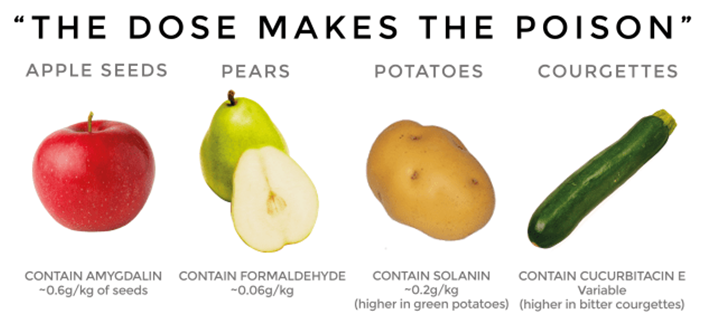Assignment Toxicology Associated With Food
The field of food toxicology has been an area of interest for scientists, health researchers, and academician to explain the natural occurring toxins (including metals) found in diverse foods, their nature, responses and effects, interaction mechanism, exposure, safety and their management. The natural toxins in food are natural contaminants and the endogenous contaminant of plant origin and animal origin and also, the contamination is due to handling and processing of making the food contain toxins (Hajeb et al, 2014). The contamination and the natural toxins if consumed in a sufficient amount (over consumption), or induce allergy reaction or unpredictable response pose health risk and increase the risk of toxicity which is harmful for the body. The objective of this document is to write a review article on the toxicants found in food products and provide a toxicological analysis of several of the toxins present in the food to offer an understanding on food toxicology by analyzing and summing up the existing published studies.
Various natural toxins as inherent constituent of food have been identified in the food toxicology literature from both plant and animal origins. According to Prashanth and Indranil (2016), the contamination of food can be biological (microbial, along with plant and animal toxins), chemical (heavy metals) and physical (improper handling, processing/ cooking) leading to food poisoning. It is also reviewed from this study that food groups like fruits (apple, peaches), vegetable (zucchini, rhubarb, and sweet potatoes/potatoes), beans (red kidney bean), and fish are identified to contain natural toxins. The study of Saravanan et al. (2016) analyzed different kinds of natural toxins in various groups of food plants and presents well-organized content for toxins in food. The research of Dolan et al. (2010) also assessed the prussic acid, hypericin, goitrogens, furocoumarins, lectins, pyrrolizidine alkaloids and other naturally occurring toxins. This study provides a good extent of coverage of the natural toxins but do not discuss on the heavy metals in food. The study provides knowledge of the specific food types that contains natural toxins and classified them which are harmful for human in high concentrations.

Figure 1: Common food containing natural toxic chemicals
(Source: Ci, 2014)
Phytotoxins/ Cyanogenic glycosides
These are the toxic chemicals that are released by plants and are naturally occurring in over 200 plants species and is toxic depending on the concentration level of cyanide and its exposure to humans during consumption of foods contains cyanogenic glycosides.
Amygdalin is cyanogenic glycoside which is a natural toxin which is found in the seeds of fruits of peach, apple, plum and apricot in small quantities that do not pose risk to human health. However, high seeds consumption is associated with cyanide poisoning.
Prussic acid is other cyanogenic glycosides popular as hydrogen cyanide, a plant toxin that is found in the leaves of fruits of apple and cherry, pits of apricots, and peaches and vegetable (cassava) where this poisoning can prevent the body cells from making use of oxygen and caused cell injury, premature death of cell and damage to tissue. It is also called as hydrocyanic acid when contact with emulsion enzymes or beta-glycosidase release the cyanide leads to its poisoning and causing respiratory problem and in some cases cardiac arrest (Dolan and Burdock, 2010).

Figure 2: Release of cyanide by cyanogenic glycosides toxins
(Source: Yamane et al., 2010)
Apart from hydrocyanic acid, hypericine (in flowering plant – St John’s-wort herb leaves and flower, beverages), saffrole (in Sassafras plant, nutmeg, mace, fish products, poultry foods) and agaric acid (in food that contain mushroom and foods) are also a naturally occurring toxic substance. The consumption of St. John’s wort by humans in high dose can lead to liver problems and result in photosensitization. In United States, the regulations are set by Food and Drug Administration (FDA) for the use of hypericin-free form of alcohol distillate for alcoholic beverages). Also, the regulations set these naturally occurring toxic substances as per Food Safety and Standards Authority of India (FSSAI) is shown in below figure.

Figure 3: Limit for toxic substances in food articles
(Source: Indiacode.nic.in, 2011)
There has been amendment towards the regulations for the presence of maximum limit as 10 ppm for hydrocyanic acid in food stuff like Cassava flour and Sago by FSSAI (FoodSafetyHelpline.com, 2016).
Another cyanogenic glycoside that is present in the roots and leaves of cassava and flax is Linamarin toxin which is decomposed to from hydrogen cyanide causing dietary toxicity and poisoning in case when these vegetables are not processes properly and is consumed. This toxin is also reported for risk of diabetes (Dolan et al., 2010).
They also called as goitrogens that contains suplhur and are natural toxins that are present in the number of vegetables like sweet potatoes, spinach, soybeans, cauliflower, cabbage, broccoli, brussels sprouts, mustard greens, and radish and fruits like strawberries, peaches, and pears. This toxin release goitrins and have ability to suppress the iodine uptake interfere with the iodine metabolism and causes enlarge thyroid gland (goiter) (The Times of India, 2015).
These are natural toxins which include chaconine and solanines which are poisonous in nature occurs naturally in potatoes tuber to defend from insects, microorganisms, sunlight, etc. These are also present in tomatoes (red and green variants), eggplants and other solanacea plants. These toxin pose risk to the nervous system and also cause digestive disorders. According to Mol et al. (2011), the glycoalkaloids are stress toxins highlighted by green patches on potato which needs to be cuts as cooking process cannot destroy this toxin.
Another stress toxin is Furocoumarins release to in response to physical damage or other kind of stress. This toxin occurs in Parsnips, celery roots and citrus plants such as lime and lemon. According to Melough et al. (2018), parsnips needs to be properly peeled and cooked as its high exposure to body result in poisoning that leads to allergic reactions (skin) and gastrointestinal disorders.
Lectins are plant toxin that are present in variety of beans (but high in concentration in red kidney beans) which require the raw beans to be soaked in water for few hours and a proper boiling process (for 10 minutes) before cooking to reduce the toxin exposure. It results in gastrointestinal problems, and vomiting (Dolan et al., 2010).
It can be evaluated that the study of Dolan et al. (2010) helps in identification of plant poisoning and harmful effects in common ingested foods thus, gave a range of potentially harmful naturally occurring toxins.
Cucurbitacins toxins are found in Zucchini giving them a bitter taste and intake of these causes vomiting, diarrhea and digestive disorders. Oxalyldiaminopropionic acid (ODAP) is a natural toxin found in the Indian pea and Oxalic acid in Rhubarb plant leaves and stems which can cause neurological, respiratory, and gastraointestinal problems (Mol et al., 2011).
Pyrrolizidine alkaloids toxins are present in Asteraceae, Boraginaceae, and Fabaceae species of plants. High consumption of these plant toxins containing food products (herbal teas, herbs, honey, spices cereals, cereal products) can pose serious health risk and can cause cancer.
Apart from these, the natural toxins are found in mushroom plant as fungal toxins which are more commonly occurring in wild mushrooms. This toxin causes mushroom poisoning leading to gastrointestinal disorders. In addition, muscimol and muscarine are another toxins present in wild mushroom which can effect on nervous system and cause state of confusion, and hallucinations and also affect liver and kidney causing vomiting and diarrhoea.
Another is mycotoxins that is released by mould (fungus) and can grow in food products such as cereals products, nuts, spices and dried fruits and consumption of mycotoxins contaminated food can result in immune deficiency and risk of cancer (Williams, 2012).
Also, algal toxins are contained in fish like shellfish such as mussels, oysters and scallops and on consumption of high concentration by humans lead to vomiting, diarrhea, vomiting, and risk of paralysis (Twiner et al., 2012).
Williams (2012) discussed the toxicity of heavy metal like selenium, mercury and cadmium for food safety.
Mercury: It is contained in fish which can vary in range of 10 mg to 1500mg/kg in organic form which can result in mercury intoxication/ poisoning.
Cadmium: Plants can accumulate varying level of cadmium which on consumption above 50μg per day can affect kidney functioning and lead to kidney failure.
Selenium: This metal in foods causes gastrointestinal problems, skin lesions and its discoloration.
Arsenic: The rice (brown rice) and grains, fruits, and vegetables contains this heavy metal and long-term consumption is associated with heart diseases and risk of skin and lung cancer.
The below figure highlight the methods to lower the exposure of heavy metals in some of the common food.
Figure 4: Heavy Metals reduction methods in foods
(Source: Hajeb et al., 2014)
It can be summarized that natural toxins in foods causes food poisoning and toxicological health risk when consumed in sufficient quantity which can be due to their intake or improper handling/ processing (cooking) of the food plants. It is concluded that there needs to be careful consumption in terms of selection and quantity limitation of food and processing of raw food to reduce the toxicological risk from the natural toxins and risk of health problems from the toxin poisoning.
Compound interest (Ci). 2014. Natural vs. Man-Made Chemicals – Dispelling Misconceptions [Online] Available at: https://www.compoundchem.com/2014/05/19/natural-vs-man-made-chemicals-dispelling-misconceptions/ (Accessed 14 March 2019).
Dolan, L.C., Matulka, R.A. and Burdock, G.A., 2010. Naturally occurring food toxins. Toxins, 2(9), pp.2289-2332.
FoodSafetyHelpline.com. 2016. FSSAI proposes amendments of standards for Hydrocyanic acid in Sago [Online] Available at: https://foodsafetyhelpline.com/2016/08/fssai-proposes-amendments-standards-hydrocyanic-acid-sago/ (Accessed 14 March 2019).
Hajeb, P., Sloth, J.J., Shakibazadeh, S., Mahyudin, N.A. and Afsah‐Hejri, L., 2014. Toxic elements in food: Occurrence, binding, and reduction approaches. Comprehensive Reviews in Food Science and Food Safety, 13(4), pp.457-472.
Indiacode.nic.in. 2011. Ministry of Health and Family Welfare [Online] Available at: https://indiacode.nic.in/ViewFileUploaded?path=AC_CEN_39_65_00002_200634_1517807326101/regulationindividualfile/&file=5.FSS+%28Contaminants%2C+Toxins+and+Residues%29+Regulation%2C+2011.pdf (Accessed 14 March 2019).
Melough, M.M., Cho, E. and Chun, O.K., 2018. Furocoumarins: A review of biochemical activities, dietary sources and intake, and potential health risks. Food and Chemical Toxicology, 113, pp.99-107.
Mol, H.G.J., Van Dam, R.C.J., Zomer, P. and Mulder, P.P., 2011. Screening of plant toxins in food, feed and botanicals using full-scan high-resolution (Orbitrap) mass spectrometry. Food Additives & Contaminants: Part A, 28(10), pp.1405-1423.
Prashanth, M. and Indranil, C., 2016. Food Poisoning: Illness Ranges from Relatively Mild Through To Life Threatening. Journal of Medical and Health Sciences, 5(4), pp.1-19.
Saravanan, D., Thirumalai, D., Sivakumar, A. and Asharani, I.V., 2016. A systematic review of natural toxins in food plants. International Journal of Research in Ayurveda and Pharmacy, 7(2), pp. 52-57.
The Times of India. 2015. Hidden toxic in healthy food [Online] Available at: https://timesofindia.indiatimes.com/life-style/health-fitness/health-news/Hidden-toxic-in-healthy-food/articleshow/6219474.cms (Accessed 14 March 2019).
Twiner, M.J., Doucette, G.J., Rasky, A., Huang, X.P., Roth, B.L. and Sanguinetti, M.C., 2012. Marine algal toxin azaspiracid is an open-state blocker of hERG potassium channels. Chemical research in toxicology, 25(9), pp.1975-1984.
Williams, P., 2012. Food toxicity and safety. Essentials of Human Nutrition, 415.
Yamane, H., Konno, K., Sabelis, M., Takabayashi, J., Sassa, T. and Oikawa, H., 2010. Chemical defence and toxins of plants, Reference Module in Chemistry, Molecular Sciences and Chemical Engineering, 4, pp. 339-385.


